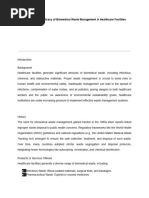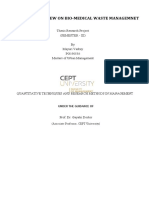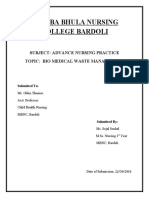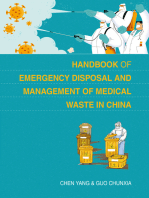RRL
RRL
Uploaded by
Princess Aira Bucag CarbonelCopyright:
Available Formats
RRL
RRL
Uploaded by
Princess Aira Bucag CarbonelOriginal Title
Copyright
Available Formats
Share this document
Did you find this document useful?
Is this content inappropriate?
Copyright:
Available Formats
RRL
RRL
Uploaded by
Princess Aira Bucag CarbonelCopyright:
Available Formats
Health care waste (WHO)
all waste generated by healthcare
establishments, research facilities, and health laboratories classified as
1. non-risk/general healthcare waste/domestic waste 2. hazardous waste
Prss, A., Giroult, E., Rushbrook, P., 1999. Safe Management of Wastes From Health Care Activities. World Health Organization, Geneva
Classification of Hazardous Waste (DENR) based on these four characteristics accordance with the Toxicity Characteristic Learning Procedure (TCLP):
Ignitable Corrosive Reactive Toxic
Department of Environment and Natural Resources. 2004. Hazardous Waste Management. Procedural Manual Title III of DAO 92-29
All individuals exposed to hazardous health-care waste are potentially at risk
Prss, A., Giroult, E., Rushbrook, P., 1999. Safe Management of Wastes From Health Care Activities. World Health Organization, Geneva
Certain infections, caused by more resilient agents, pose a significant risk to the general public and to hospital patients
Mhlich, M. et. al. 2003. Comparison of infectious waste management in European hospitals. Institute for Environmental Medicine and Hospital Epidemiology, Freiburg University Hospital, Freiburg, Germany
health-care workers, particularly nurses, are at greatest risk of infection other hospital workers and waste-management operators outside health-care establishments individuals who scavenge on waste disposal sites lower risk for patients and the public
Mhlich, M. et. al. 2003. Comparison of infectious waste management in European hospitals. Institute for Environmental Medicine and Hospital Epidemiology, Freiburg University Hospital, Freiburg, Germany
Metropolitan Manila Authority (MMA) Ordinance No. 16 Hospital Licensure Law (Republic Act No. 4226) Toxic Substances and Hazardous and Nuclear Waste Control Act of 1990 (Republic Act No. 6969
Soncuya, Matias, Lapid. 1997. Hospital Waste Management in the Philippines, two Case Studies in Manila. WASTE. Urban Waste Expertise Programme
1) black trash bag for non-infectious dry waste 2) green trash bags for non-infectious wet waste 3) yellow trash bags for dry and wet chemical and
use four types of trash bags for easy identification of waste:
other potentially infectious waste, pathological waste, chemical waste and sharps contained in puncture-proof containers covered with solution of lime 4) orange trash bags with trefoil sign for radioactive waste that will be stored in the hospital until rendered as inactive and/or disposed in accordance with the prescribed rules and regulations of the Philippine Nuclear Research Institute
hospitals are categorized as government or private hospitals specifies the needed physical facilities of a hospital for solid waste management such as the physical plant, hospital equipment and maintenance of these physical facilities
covers the importation, manufacture, processing, handling, storage, transportation, sale, distribution, use and disposal of all unregulated chemical substances and mixtures in the Philippines defines the prohibited acts and provides for administrative and criminal penalties
wastes, segregated or not, are collected by workers employed by the health care establishment(usually cleaners or janitors of the premises)
aware of local opportunities for recycling of components of the waste
unaware of, or insensitive to, the hazards associated with handling health care waste
generally take no precautions in handling, transporting and separating the waste not supplied with protective clothing or special equipment
Pescod, S. 1998. Hospital Waste Management in Four Major Cities. WASTE. Urban Waste Expertise Programme
plastic bags, covered bins/trash cans, and glass jars with covers
due to inadequate segregation of infectious from non-infectious much of the generated hospital waste is being disposed directly to municipal landfills
Department of Environment and Natural Resources. 1993. Pasig River Rehabilitation Program: Feasibility Report on Hospital Hazardous Waste Management in Metro Manila. Volume I
collected by the municipal waste collection service transported for disposal with municipal waste all types of wastes are mixed and transported, often along with municipal solid waste, to municipal landfills
Pescod, S. 1998. Hospital Waste Management in Four Major Cities. WASTE. Urban Waste Expertise Programme
existing treatment capacity is insufficient for the proper disposal of the major part of medical wastes generated in Metro Manila area the existing capacity for incinerating these wastes totals to less than 3 tons/day total daily quantity of dangerous medical wastes generated was estimated to at least 12.4 tons
Department of Environment and Natural Resources. 1993. Pasig River Rehabilitation Program: Feasibility Report on Hospital Hazardous Waste Management in Metro Manila. Volume I
In developing countries, medical waste has not received much attention and it is disposed of together with domestic waste Lack of a system of medical waste management, a lack of necessary supplies and facilities, a lack of knowledge among health workers and a lack of coordination among different ministries. A national program for medical waste management is essential in Palestine
Massrouje, HTN., 2001. Medical waste and health workers in Gaza governorates. Eastern Mediterranean Health Journal
In Lagos Metropolis, Nigeria, there is absence of full compliance with the protocol stipulated in the guidelines and standards of environmental pollution control There were problems in collection, segregation, storage, treatment, and disposal among the hospitals that were observed
Longe, E.O., Williams, A., 2006. A Preliminary Study of Medical Waste Management in Lagos Metropolis, Nigeria. Iran Journal of Environ. Health Sci. Eng., 3:2:133-139
In Dhaka, Bangladesh there is no proper, systematic management of medical waste except in a few private Health Care Establishments that segregate their infectious wastes Some cleaners were found to salvage used sharps, saline bags, blood bags and test tubes for resale or reuse
Hassan, M., Ahmed, S., Rahman, K., Biswas, T. 2008. Pattern of medical waste management: existing scenario in Dhaka City, Bangladesh. BMC Public Health. 8:36
Evidence that there are many flaws in the compliance, implementation and even in the construction of guidelines concerning hospital management in the Philippines and around the world Several studies have recommender several steps that may be undertaken to address these flaws
Recommendations:
establishment of directorates responsible for
medical waste management coordination of different ministries provision of adequate supplies and health education including encouragement of studies on different aspects of medical waste (creation of database information in different sectors, risk analysis and disposal methods)
Massrouje, HTN., 2001. Medical waste and health workers in Gaza governorates. Eastern Mediterranean Health Journal
Case studies in the Philippines have only focused on two distinct hospitals in Metro Manila Should include the University of Santo Tomas Hospital
You might also like
- The Problem and Its BackgroundDocument8 pagesThe Problem and Its BackgroundAlna JaeNo ratings yet
- Waste Management in Small Hospitals: Trouble For EnvironmentDocument5 pagesWaste Management in Small Hospitals: Trouble For EnvironmentYuan Lucky RNo ratings yet
- Bio Medical WasteDocument6 pagesBio Medical Wastekritishah299750% (6)
- ISJ FinalDocument19 pagesISJ Finalnana nanaNo ratings yet
- Objectives of Hospital Waste ManagementDocument3 pagesObjectives of Hospital Waste ManagementNajiya Khan100% (3)
- Biomedical Waste ManagementDocument37 pagesBiomedical Waste ManagementDr.Rajesh KamathNo ratings yet
- Hospital ETP STP Paper PDFDocument7 pagesHospital ETP STP Paper PDFamitkenNo ratings yet
- Abdel Salam2010Document12 pagesAbdel Salam2010jesusNo ratings yet
- V18I07A103 7GKA6-Cd14ZV1eOJhtnSIDocument14 pagesV18I07A103 7GKA6-Cd14ZV1eOJhtnSIADAL, KATE CARMELANo ratings yet
- Health Care Waste Managementan Advocacypaper For Final RevisionDocument62 pagesHealth Care Waste Managementan Advocacypaper For Final RevisionNikki BarenaNo ratings yet
- Academic Research Into Radio Frequency IdentificationDocument28 pagesAcademic Research Into Radio Frequency IdentificationjayaNo ratings yet
- Hospital Waste ManagementDocument5 pagesHospital Waste ManagementUnzila AtiqNo ratings yet
- Literature Review Hospital Waste ManagementDocument7 pagesLiterature Review Hospital Waste Managementea2167ra100% (1)
- SEM ProjectDocument73 pagesSEM ProjectRahulKrishnan100% (1)
- Assmt 1Document6 pagesAssmt 1Desalegn DgaNo ratings yet
- S.subashini Hospital Waste ManagementDocument70 pagesS.subashini Hospital Waste ManagementVenkatram PrabhuNo ratings yet
- ChapterDocument12 pagesChaptermramitdahiyaNo ratings yet
- Op No 14 - Case Studies On Healthcare Waste Management PracticesDocument144 pagesOp No 14 - Case Studies On Healthcare Waste Management PracticesChristine Rodriguez-GuerreroNo ratings yet
- Biomedical Waste Management OBJECTIVEDocument5 pagesBiomedical Waste Management OBJECTIVESaumya GuptaNo ratings yet
- WHO Classification of Medical WasteDocument8 pagesWHO Classification of Medical WasteBavitha YadavNo ratings yet
- Health Care Waste Management Practice in A HospitalDocument5 pagesHealth Care Waste Management Practice in A HospitalRekha SinghNo ratings yet
- Assessing The Efficacy of Biomedical Waste Management in Healthcare FacilitiesDocument5 pagesAssessing The Efficacy of Biomedical Waste Management in Healthcare FacilitiesJDS TVNo ratings yet
- Bio Medical WasteDocument6 pagesBio Medical WastePriscilla SolomonNo ratings yet
- research correctedDocument7 pagesresearch correcteddammydebbie18No ratings yet
- Literature Review by Mayuri VarkeyDocument7 pagesLiterature Review by Mayuri VarkeyMayuri VarkeyNo ratings yet
- Chapter 1: Introduction: 1.1 Introduction To The TopicDocument30 pagesChapter 1: Introduction: 1.1 Introduction To The TopicShivaniNo ratings yet
- Action Plan Outline FormatDocument9 pagesAction Plan Outline FormatJocelyn Mae CabreraNo ratings yet
- Research ApproachDocument3 pagesResearch ApproachMisiel NameteNo ratings yet
- Medical Waste ManagementDocument25 pagesMedical Waste ManagementLubaba SalahNo ratings yet
- Neha Chopra SOP - 33Document5 pagesNeha Chopra SOP - 33Gautam ShrivastavaNo ratings yet
- Hospital Waste Management and Environmental Problems in IndiaDocument16 pagesHospital Waste Management and Environmental Problems in Indiabhaskardev84No ratings yet
- National Law Institute UniversityDocument17 pagesNational Law Institute UniversityKriti SinghNo ratings yet
- Applications of Bioremediation in Biomedical Waste Management: Current and Future ProspectsDocument17 pagesApplications of Bioremediation in Biomedical Waste Management: Current and Future Prospectsrhv8brasilNo ratings yet
- Project ChemistryDocument18 pagesProject ChemistryA MNo ratings yet
- Health Care Waste Management of Funeral Homes in Cebu City - RRLDocument16 pagesHealth Care Waste Management of Funeral Homes in Cebu City - RRLDiane Sumalinog100% (1)
- Maniba Bhula Nursing College Bardoli: Subject: Advance Nursing Practice Topic: Bio Medical Waste ManagementDocument12 pagesManiba Bhula Nursing College Bardoli: Subject: Advance Nursing Practice Topic: Bio Medical Waste ManagementSatyam RathoreNo ratings yet
- Biomedical Waste Generation and Management in Public Sector Hospital in Lagos City Nigeria - 1530184001Document6 pagesBiomedical Waste Generation and Management in Public Sector Hospital in Lagos City Nigeria - 1530184001oluwatobiloba stevensNo ratings yet
- Management of Health Care Waste in Sri LankaDocument3 pagesManagement of Health Care Waste in Sri LankaGariman KurniawanNo ratings yet
- Best Practices Waste MGMT PhilippinesDocument69 pagesBest Practices Waste MGMT PhilippinesAzrael CervantesNo ratings yet
- ConclusionDocument8 pagesConclusionkhadijaNo ratings yet
- Review Related Literature Hospital Waste ManagementDocument5 pagesReview Related Literature Hospital Waste Managementeatlotbnd100% (1)
- PlasticsInHealthcare Report 2018Document37 pagesPlasticsInHealthcare Report 2018Tan Bak PingNo ratings yet
- Comparison On Disposal Strategies For Clinical Waste: Hospitals in Sri LankaDocument9 pagesComparison On Disposal Strategies For Clinical Waste: Hospitals in Sri LankaH.R. SrikanthaNo ratings yet
- 81-Article Text-523-2-10-20210318Document6 pages81-Article Text-523-2-10-20210318Risnawa Puji AstutiNo ratings yet
- Maniba Bhula Nursing College Bardoli: Subject: Advance Nursing Practice Topic: Bio Medical Waste ManagementDocument12 pagesManiba Bhula Nursing College Bardoli: Subject: Advance Nursing Practice Topic: Bio Medical Waste ManagementRinal BaradNo ratings yet
- Assessment of Medical Waste Management iDocument36 pagesAssessment of Medical Waste Management iSANI MUHAMMADNo ratings yet
- Review of Literature of Biomedical Waste ManagementDocument8 pagesReview of Literature of Biomedical Waste ManagementafdtfhtutNo ratings yet
- Residuos Hospitalarios Peligrosos PDFDocument11 pagesResiduos Hospitalarios Peligrosos PDFDavid Villarroel VásquezNo ratings yet
- Wolayita Sodo Hospital Waste Water EvaluationDocument9 pagesWolayita Sodo Hospital Waste Water EvaluationFasil GeberemeskelNo ratings yet
- Waste ManagementDocument14 pagesWaste Managementhasithara19911007No ratings yet
- IJRPR22122Document6 pagesIJRPR22122jamantillarNo ratings yet
- Health Care Waste Management in Bangladesh A Sustainable Guideline - Mohammad AliDocument12 pagesHealth Care Waste Management in Bangladesh A Sustainable Guideline - Mohammad AliMohammad AliNo ratings yet
- Hospital Waste ManagementDocument10 pagesHospital Waste ManagementRouble VohraNo ratings yet
- Research in Nursing 1Document6 pagesResearch in Nursing 1Misiel NameteNo ratings yet
- Review of Related Literatures and StudiesDocument10 pagesReview of Related Literatures and StudiesAlna JaeNo ratings yet
- N Engg - Ijget - Biomedical - D. Shreedevi - Dual - IjgmpDocument11 pagesN Engg - Ijget - Biomedical - D. Shreedevi - Dual - Ijgmpiaset123No ratings yet
- Journal LingkunganDocument6 pagesJournal LingkunganDelwim LibranitoNo ratings yet
- Handbook of Emergency Disposal and Management of Medical Waste in ChinaFrom EverandHandbook of Emergency Disposal and Management of Medical Waste in ChinaNo ratings yet
- Solid Wastes ManagementFrom EverandSolid Wastes ManagementStephen BurnleyNo ratings yet
- Common Childhood Solid Tumors (Part 2)Document56 pagesCommon Childhood Solid Tumors (Part 2)Princess Aira Bucag CarbonelNo ratings yet
- Lecture Combined PDFDocument81 pagesLecture Combined PDFPrincess Aira Bucag CarbonelNo ratings yet
- Infectious Deseases in Pregnancy: Margie Reyes-Posadas, M.D. Ob GynDocument54 pagesInfectious Deseases in Pregnancy: Margie Reyes-Posadas, M.D. Ob GynPrincess Aira Bucag CarbonelNo ratings yet
- The Following Presentation Contains Slides Not Suitable For Very Young Audiences. Parental Guidance Is Recommended.Document102 pagesThe Following Presentation Contains Slides Not Suitable For Very Young Audiences. Parental Guidance Is Recommended.Princess Aira Bucag CarbonelNo ratings yet
- Infections of The Upper & Lower Genital Tract: Teresita R. Tablizo Fpogs, FpsuogDocument76 pagesInfections of The Upper & Lower Genital Tract: Teresita R. Tablizo Fpogs, FpsuogPrincess Aira Bucag CarbonelNo ratings yet
- Chapter 56: DERMATOLOGICAL Disorders: Dr. Teresita R. Tablizo MD, FPOGS, Fpsuog, FpsmsDocument17 pagesChapter 56: DERMATOLOGICAL Disorders: Dr. Teresita R. Tablizo MD, FPOGS, Fpsuog, FpsmsPrincess Aira Bucag CarbonelNo ratings yet
- AiraDocument17 pagesAiraPrincess Aira Bucag CarbonelNo ratings yet
- Ethical Issues in Nursing PracticeDocument17 pagesEthical Issues in Nursing PracticePrincess Aira Bucag Carbonel100% (1)
- VMUFDocument17 pagesVMUFPrincess Aira Bucag CarbonelNo ratings yet
- Nurse ResumesDocument4 pagesNurse ResumesPrincess Aira Bucag CarbonelNo ratings yet
- Name of Students Date Signature Amount PaidDocument3 pagesName of Students Date Signature Amount PaidPrincess Aira Bucag CarbonelNo ratings yet
- RRLDocument20 pagesRRLPrincess Aira Bucag CarbonelNo ratings yet







































































